Friday, March 1, 2007
Today was the second and last day that 1S1P Assignment #2 reports
could be turned in.
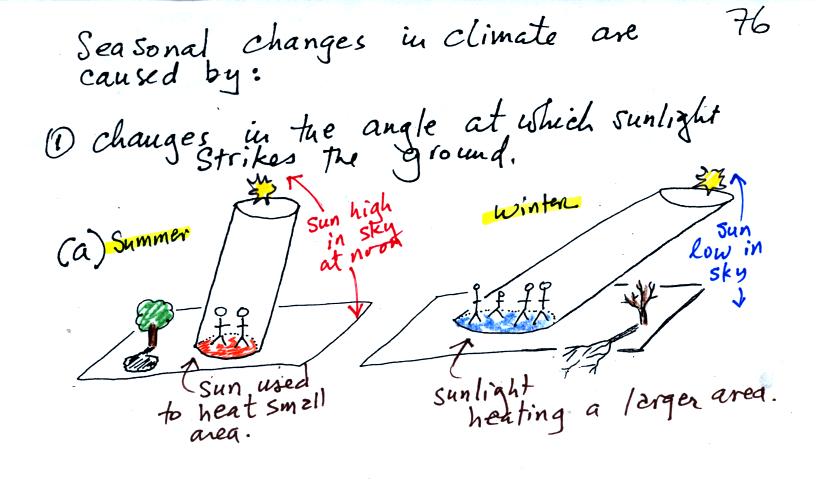
Here's where we left off on Wednesday. In the summer the sun is
high in the sky at noon. Sunlight arriving at the ground is used
to warm a fairly small area of ground. In the winter the sun is
lower in the sky and the same sunlight is used to try to warm a larger
area.
These area differences can be illustrated using three pieces
of PVC
pipe. The end of one piece is cut perpendicularly. The ends
of the 2nd and 3rd pieces are cut at 30o and 60o
angles.
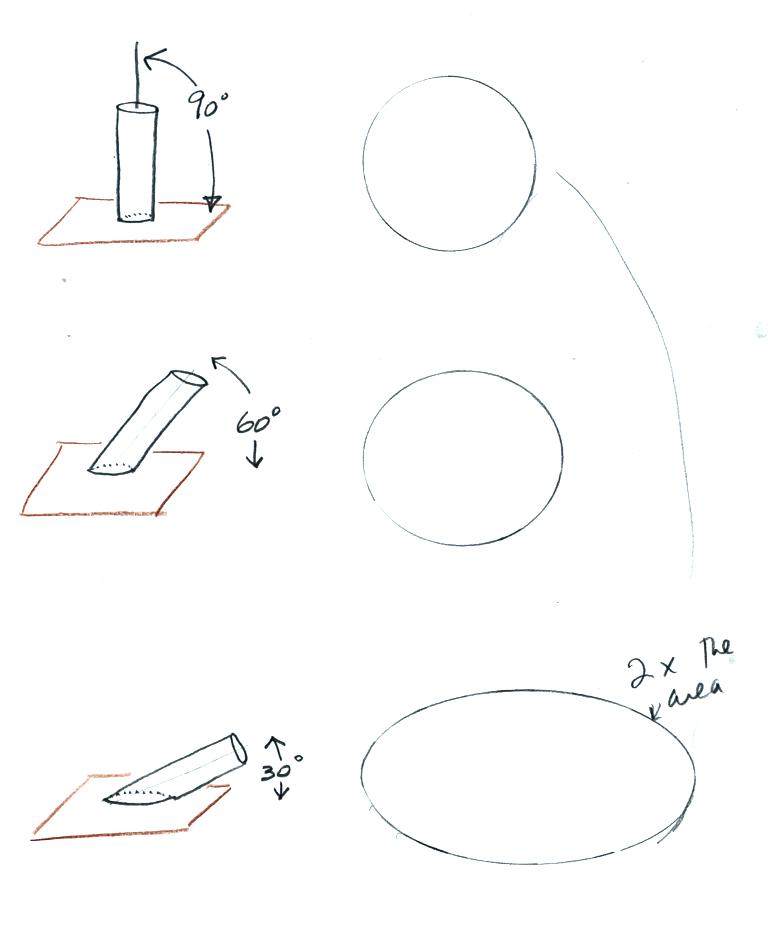
The end of the 30o pipe covers twice the area of
the 90o
pipe. The
end of the 60o pipe is a little larger but not a lot larger
than area of the end of the 90o
pipe.
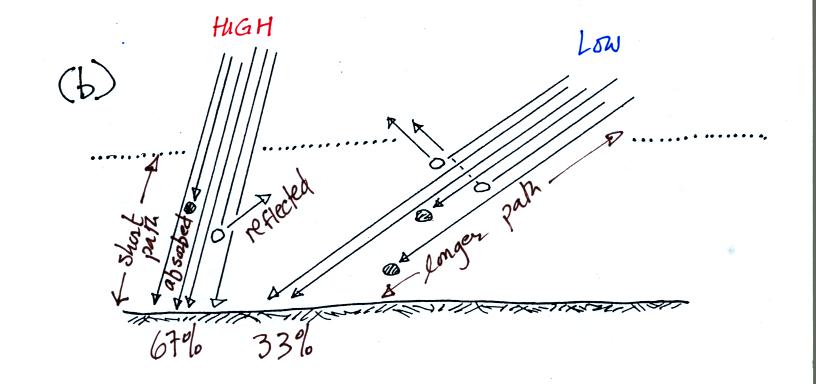
As sunlight passes through the atmosphere it can be absorbed
or
reflected. On average (over the globe) only about 50% of the
sunlight arriving at
the top of the atmosphere actually makes it to the ground. A beam
of sunlight that travels through the atmosphere at a low angle (right
picture above) is less intense than beam that passes through the
atmosphere more directly (left picture).

The sun shines for more time in the summer than in the
winter. In
Tucson the days are around 14 hours long near the time of the summer
solstice. In the winter the sun only shines for 10 hours on the
winter solstice. Days are 12 hours long on the equinoxes.
Next we
will look at what happens on the earth on the equinoxes and the
solstices. The situation on the equinoxes is simplest, we will
start there. This is covered on p. 77a in the photocopied class
notes.
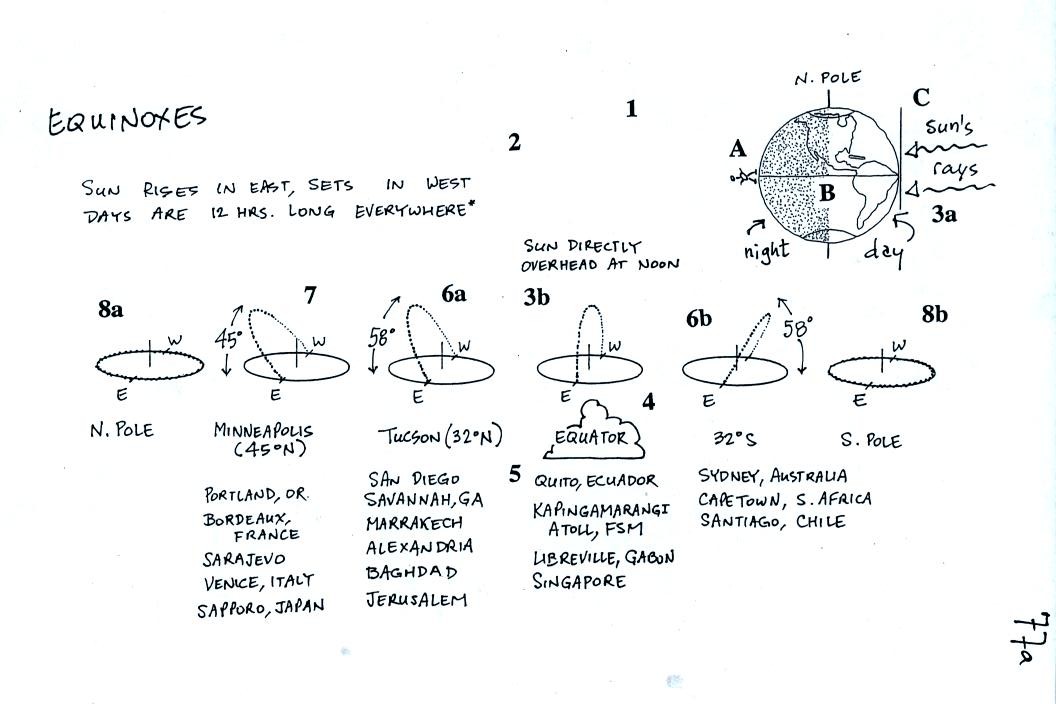
There is a lot of information on this figure. We
worked
through this figure numbered point by numbered point. You'll find
written explanations of each point below and on p. 77b in the
photocopied notes.
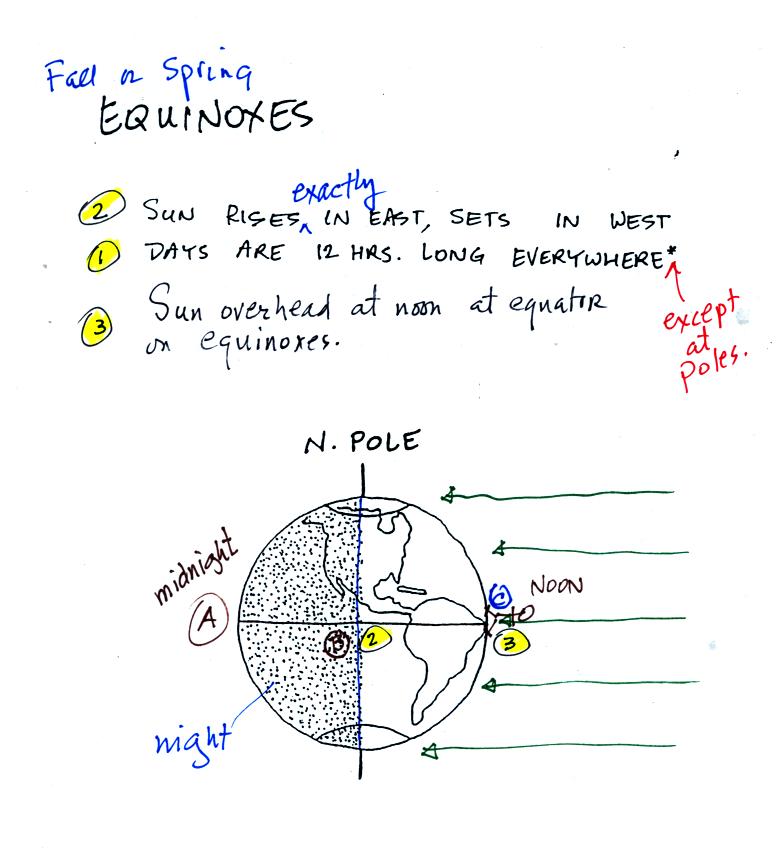
Notice first of all that you don't see 24 hours of day or 24
hours of
night at the north pole. That is how you know this is one of the
equinoxes and not the summer or winter solstice.
1. The
line separating day from night passes through the north and south
poles. As the earth spins on its axis, a person standing anywhere
on the globe will spend exactly half the day on the nighttime side of
the picture and half the day on the daytime side of the picture.
Thus the day and night are both 12 hours long. This is true
everywhere except at the poles. We'll see what happens at the
poles later.
2.
Imagine standing at the equator. At point A you are positioned in
the middle of the nighttime side of the globe; it is midnight at Point
A. 6 hours later you will be standing at Point B where you will
move from night to day; this is sunrise. To see the sun you must
look exactly back along one of the rays of light coming from the
sun. You must turn and look straight east to do this. One
the equinoxes, the sun will rise in the east (not just somewhere in the
east but exactly due east). This only happens on the spring and
fall equinox. The rest of the year the sun will rise south or
north of east.
3. Six
hours later you arrive at Point C; it is noon. Now to see the sun
you must tilt your head and look straight overhead. The sun
passes directly overhead at noon at the equator on the equinoxes.
THe picture above shows the earth viewed from outer space. We
will next look at the sun's path in the sky viewed from the ground
where most of us will spend our entire lives.
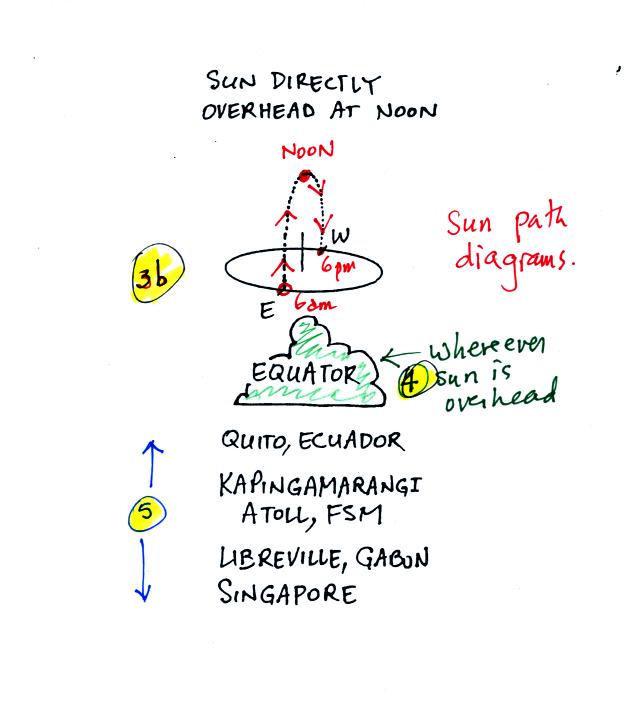
3.
This
shows the path of the sun at the equator. The sun rises in the
east at 6 am, passes overhead at noon, and sets in the west at 6
pm.
4. The
cloud shown next to Point 4 above refers to a band of clouds that
circles the globe at the latitude where the sun passes overhead at
noon. This marks the position of the "intertropical convergence
zone (ITCZ)"; we'll learn more about the ITCZ later in the
semester. You can usually make out this band of clouds on a global
satellite picture. At the present time, just a few days
after the fall equinox the band of clouds is near the equator. It
will move south of the equator as we get closer to the winter
solstice. Then it will move back to the equator by next March and
move into the northern hemisphere next summer.
5. A
list of few cities that are located on or very close to the equator.
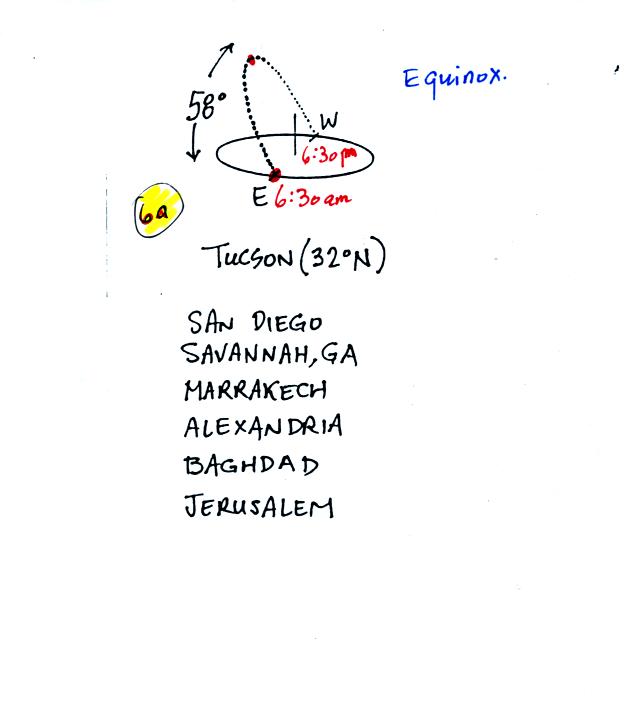
6a.
This sun path diagram shows the path that the
sun follows in the sky on the equinoxes in Tucson (or another city
located at 32o N latitude). The sun rises in the east
(just like
it does elsewhere on the globe) at around 6:30 local time, reaches its
highest point in the sky (58o above the southern horizon) at
about
12:30 and sets in the west at about 6:30 pm.

6b.
In
the southern hemisphere the sun rises in the east, travels into the
northern sky and then
sets in the west.
8b.
The
sun circles the sky at the horizon at the south pole. It is
traveling in the opposite direction than at the north pole.
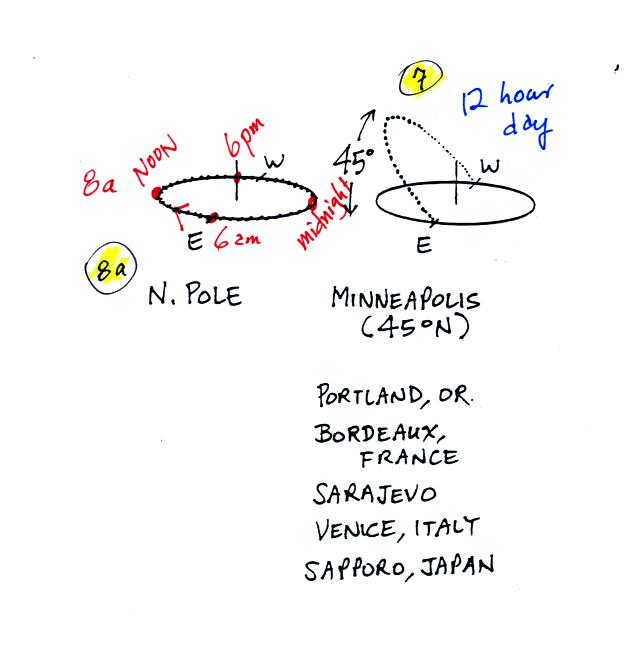
7.
At Minneapolis the sun rises in the east,
doesn't get quite as high in the sky at noon (only 45o above
the
southern horizon) and sets in the wet. Even though the sun shines
for the same amount of time in Minneapolis as it does in Tucson (12
hours), Minneapolis will receive less energy during the day because of
the lower elevation angle.
8a.
At the north pole the sun really
doesn't rise or set. At 6 am you would find the sun right on the
horizon in the east. At noon it would move south. The sun
would be visible at midnight in the north.
The newspaper clipping below shows what can happen if you are not
careful crossing a busy street late in the afternoon (or early in the
morning) on or around the equinoxes.

In this case the car driver would have had the sun shining directly in
his/her eyes and might really not have seen the pedestrian crossing the
street.
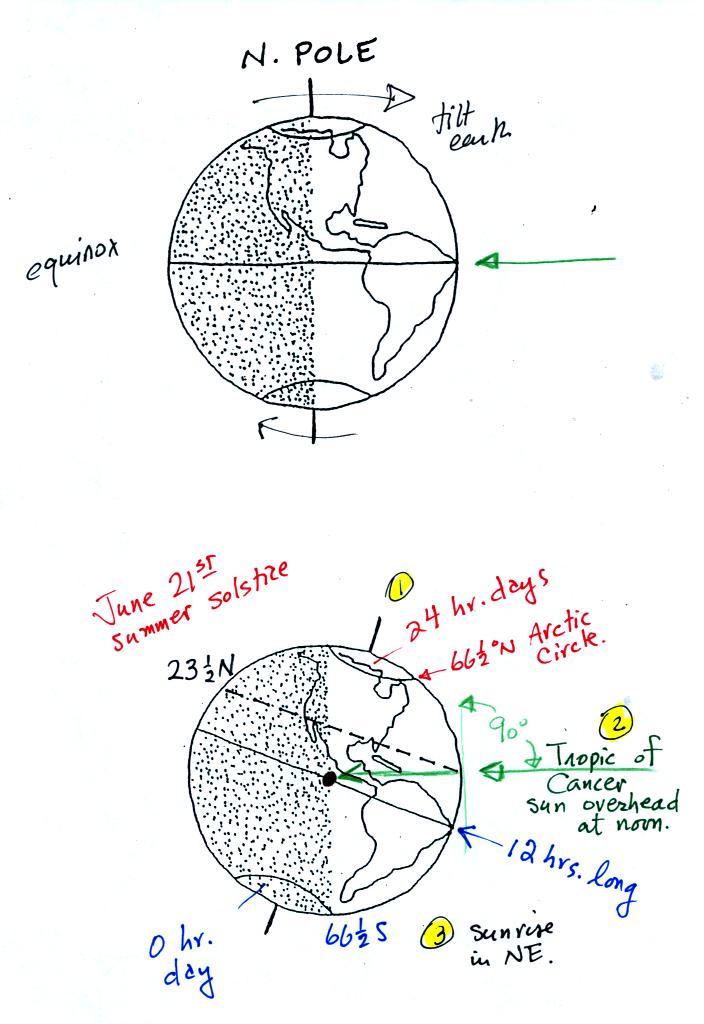
To understand the summer solstice imagine tilting the N. Pole toward
the sun.
1. Note that there
are now 24 hours of daylight everywhere north of the Arctic
Circle. There are 0 hours of daylight south of the Antarctic
Circle. The Equator is halfway between and has 12 hour days
(we'll find that is the case year round)
2. The sun will now
pass straight overhead at noon at the Tropic of Cancer (23.5 N
latitude).
3. Sunrise in north
of east, sunset to the north of west.
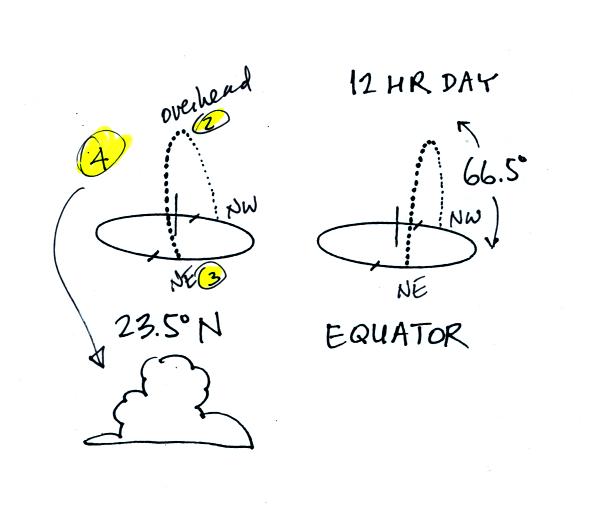
At the equator the sun rises in the NE and sets in the NW. It
doesn't pass overhead, but with a 66.5 degree elevation angle the
sunlight is still pretty intense at noon. The days are 12 hours
long.
2. The sun passes
overhead at noon at 23.5 N latitude on the June 21 summer
solstice.
3. The sun
rises in the NE and sets in the NW
4. The band of
clouds circling the globe has now moved north of the equator to near
23.5 N latitude.

5. Note the increase in the length of the daylight hours as
you move from the equator (12 hour days) to north of the Arctic Circle
(24 hours of daylight). This factor would act to increase the
amount of sunlight energy arriving at the ground (the longer the sun is
in the sky the more energy will arrive at the ground).
However the sun is lower and lower in the sky at
higher latitudes. This works to decrease the intensity of the sunlight
arriving at the ground and means that the sunlight will warm larger
areas of ground. Even though the days in Minneapolis are longer
than in Tucson, Minneapolis is cooler in the summer than Tucson.
This is because the low sun angle in Minneapolis more than overcomes
the longer day length.
6. In Tucson the sun rises in the NE and sets in the
NW. It is 81.5 degrees above the southern horizon at noon, pretty
nearly directly overhead.
7. Because length of day and angle of the sun in the sky
are working against each other, there is a latitude where you get the
optimal combination of the two factors that determine how much energy
arrives at the ground. This best combination is found near 30
latitude in the summer. This is where most of the worlds really
hot locations are found.













